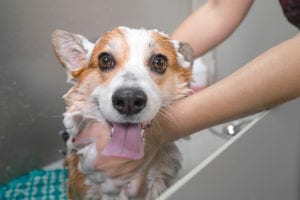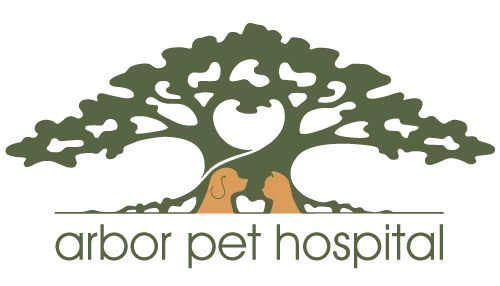At-Home Dog Grooming Tips
Good grooming habits are essential for a healthy and happy dog, and how often you groom and brush your dog depends on the breed and lifestyle of you and your dog. For example, if you own a long-haired dog such as an Afghan, or a dog with a heavy hair coat such as a Golden Retriever, or a Siberian Husky, you may have to brush and groom more often. Shorter-haired breeds such as Boxers, Beagles or short-haired Chihuahuas won’t need as much grooming. Other aspects of hygiene such as nail trims, ear cleaning and teeth cleaning should be a regular occurrence for any breed. If you’re in a pinch and are unable to book your dog with a groomer in Wilton Manors, there are some things at home you can do to keep your best friend looking sharp. If you have any questions, call Arbor Pet Hospital at (954) 565-1896.

Get the right tools
Nail trimmers
There are several items you should have in your grooming “toolbox” for your dog, including nail trimmers. Most veterinarians don’t recommend the “guillotine” type trimmers as they tend to crush your dog’s nails, so it’s best to purchase a scissors type nail trimmer.
Kwik Stop/styptic powder
This is a yellow powder that is used to stop nail bleeding if you happen to cut your dog’s nails too short. Inside the nail of the dog is something called the “quick,” which is basically a path for vessels to carry blood to the nails.
Brushes
There are a wide variety of brushes out there, and purchasing the right brushes depends on the breed of your dog. For example, bristle brushes are recommended for short-haired breeds and sleeker types of brushes are recommended for long-haired breeds. You can always check with your local groomer, or veterinarian if you have specific questions.
Fine-tooth combs
These types of combs work on any breed, especially for dogs with fine-haired coats like Shih Tzus or terriers and are great for breaking up tangles and mats.
Shampoos
There are many varieties of dog shampoos available, and most veterinarians recommend shampoos that are safe to use on your dog and are non-toxic. It is not recommended to use human shampoos on your dog as they may contain chemicals that may be harmful.
Toothbrushes and toothpaste
There are several types of toothpastes and toothbrushes available, and always make sure that these products (especially toothpaste) are meant for dogs. Never use human toothpaste on dogs as many human toothpastes contain xylitol, which can cause liver damage in your dog.
Ear cleaners
Again, there are lots of choices on ear cleaners out there. Check with your veterinarian, or a professional groomer as to which ear cleaners are recommended.
Grooming table
If you really want to get serious about grooming at home, you can invest in a grooming table. Many of these tables can be found online and are specially constructed to provide a platform while grooming your dog.
Blow dryers
Dryers specifically made for pets are also available online, and it’s important to note that some dryers can get quite hot, so always be careful not to overheat your dog or cause burns while blow-drying.
Grooming tips and tricks
First, you want grooming to be a positive experience for your dog, so positive reinforcement is always a good idea. Listed below are some ways to make grooming a positive experience for your dog.
Treats and lots of praise
To make grooming a stress-free experience, start with short sessions and reward your dog with treats. For example, train your dog to sit or stand still while you brush her, and if she is still, reward her with treats and praise.
Keep calm and groom on
It’s also a good idea to keep calm, and practice as little restraint as possible to help your dog relax. You may have to start out with short sessions to get your dog used to being grooming, brushed, or sit still for nail trims, but the goal is to keep things stress-free.
Brush and comb your dog regularly
It’s a good idea to get your dog used to being brushed and combed, even if it’s for just a minute or two. The goal is for your dog to get used to it, and maybe even like it. Just a few minutes of brushing helps to remove dirt, tangles, and shedding hair while spreading healthy skin oil around that help to keep your dog’s coat shiny and healthy. Also, regular brushing means less vacuuming and sweeping, and less pet hair on your furniture and clothes. Brushing also helps keep mats and tangles at bay, which can cause discomfort if they get out of hand. If your dog has lots of mats and tangles, veterinarians do not recommend using scissors as they can accidentally cut the skin of your dog and cause injury. In these cases, you may want to consult a professional groomer.
Bathing and Shampooing
Get your dog used to the water at an early age if possible. If you have a rescue dog or an older adopted dog, try short sessions in the bathtub or in a kiddie pool. With the exception of water dog breeds such as Golden Retrievers of Portuguese Water dogs, many dog breeds may not like the water. It’s important to introduce your dog to the water in a calm and relaxed way. Who knows, your dog may learn to like it. It’s always best to bathe your dog in warm water that’s not too hot or too cold, and best to select a shampoo made specifically for dogs. If your dog has skin issues or allergies, consult your veterinarian as to which shampoos are best. Oatmeal or soothing shampoos are popular among pet owners who have “itchy” dogs.
Trim nails regularly
Perhaps the biggest challenge for pet owners is nail trimming, especially since most dogs don’t like their feet touched. Regular walks on sidewalks and paved roads can help wear down your dog’s nails, but most dogs will need a nail trim eventually. Without regular trimming, nails on small dogs can curl back and cut into the paw pads, and if you can hear your dog’s nails click-clacking on your hardwood floor, it’s probably time for a trim. Try to get your dog used to you touching her feet, her pads and nails, and start slow, trim one or two nails each session, and gradually trim more nails if your dog lets you. You can invest in a Dremel-like nail filer; however, these tend to be noisy and a plain-old clipper is usually faster.
When you’re trimming nails, try to avoid “cutting to the quick.”
This means avoiding cutting the nails so short they bleed. If your dog has dark nails, trim a little bit at a time until you can see a black dot in the center of the nail: That means you are close to the quick. If you accidentally cut the quick and the nail starts to bleed, pat the area with styptic powder or in a pinch, cornstarch. If you have any questions about nail trimming technique, ask your veterinarian or a professional groomer to demonstrate for you.
Cleaning around the eyes
Many dog breeds such as Shih Tzus and terriers have long hair that can cover the eyes, it’s important to keep this hair trimmed. You can use a damp cloth to keep the hair around the eyes clean. Also, if you have a breed like a Bichon Frise, who are prone to tear stains, cleaning with a damp cloth regularly, or using veterinarian-approved tear-stain products are recommended.
Cleaning the ears
Always use dog-approved or veterinary-approved ear cleaning products. When using ear cleaners, make sure to read the instructions on the label. Most cleaners recommend placing several drops in each ear, massaging the base of the ear, and wiping the excess cleaner with a damp cloth or cotton ball. It’s important that you never use Q-tips on your dog’s ears or go too deep into the ear while applying drops as you could cause damage to the ear drum.
Brushing your dog’s teeth
Many veterinarians recommend brushing your dog’s teeth several times a week, especially since dental plaque can build up after 48 hours. If your dog won’t let you brush her teeth, try enzymatic toothpastes that you can apply with your finger, or place on a piece of gauze or washcloth, and massage around the gums. There are also water additives that can help prevent plaque buildup but consult your veterinarian before purchasing any of these products to make sure they’re safe for your dog.
The don’ts of grooming
There are several “don’ts” when it comes to grooming your dog.
- If you notice any unusual growths in your dog’s eyes, nose, mouth, or ears, always consult your veterinarian and try not to remove them yourself.
- When trimming your dog’s nails, try to avoid “quicking” the nail and causing them the bleed. This can be quite painful for your dog.
- Avoid shaving your dog or using scissors to trim hair. If you need your dog shaved, it’s best to have a professional groomer do the job.
- Try not to use human products on your dog, such as shampoo, conditioner, or toothpaste. As mentioned above, many human toothpastes contain xylitol, which is extremely toxic to dogs and ingestion can cause liver failure and death.
- Try to avoid non-veterinarian approved scents and essential oils on your dog. Dogs are very sensitive to smells, and many human beauty products contain ingredients that can be toxic to your dog. Also, fragrances and sprays can cause respiratory problems in sensitive dogs.
- If you suspect that your dog needs an anal gland expression, try not to do this yourself as undue pressure can cause the glands to rupture. This procedure is best done by your veterinarian.
- Try to bathe your dog in warm water and avoid bathing in cool temperatures or outside as it can result in a dangerous drop in your dog’s internal body temperature.
Regular grooming of your dog is another important step in keeping your best friend healthy and happy. Call us today at (954) 565-1896 to set up a grooming appointment for your dog!
Sources :
